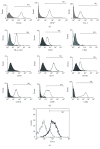Mesenchymal Stem Cells Derived and Cultured from Glioblastoma Multiforme Increase Tregs, Downregulate Th17, and Induce the Tolerogenic Phenotype of Monocyte-Derived Cells
- PMID: 31191680
- PMCID: PMC6525812
- DOI: 10.1155/2019/6904638
Mesenchymal Stem Cells Derived and Cultured from Glioblastoma Multiforme Increase Tregs, Downregulate Th17, and Induce the Tolerogenic Phenotype of Monocyte-Derived Cells
Abstract
Mesenchymal stem cells (MSCs) possess immunosuppressive properties and have been described in the tumor microenvironment of glioblastoma multiforme (GBM). This manuscript has two major topics-first, to describe isolated and cultured MSCs derived from GBM (GB-MSCs) and second, to examine their in vitro immunosuppressive capacity. Our results display cells with morphology and phenotype, clonogenic ability, and osteogenic potential, typical for MSCs. Furthermore, the cultured cells show intracellular expression of the neural markers Nestin and GFAP. They express PD-L1 and secrete TGFβ, CCL-2, PGE2, IL-6, and sVEGF. Coculturing of GB-MSCs with PBMCs isolated from healthy donors results in a decreased percentage of Th17 lymphocytes and an increased percentage of Tregs. Regarding the impact of GB-MSCs on monocytes, we establish an augmented expression of CD14 and CD86 along with diminished expression of HLA-DR and CD80, which is associated with tolerogenic phenotype monocyte-derived cells. In conclusion, our results describe in detail GBM-derived and cultured cells that meet the criteria for MSCs but at the same time express Nestin and GFAP. GB-MSCs express and secrete suppressive molecules, influencing in vitro T cells and monocytes, and are probably another factor involved in the immune suppression exerted by GBM.
Figures






References
-
- Louis D., Ellison D. Greenfield’s Neuropathology. 8th Edition. Hodder Arnold, Seth Love; 2008.
-
- Molina E. S., Pillat M. M., Moura-Neto V., Lah T. T., Ulrich H. Glioblastoma stem-like cells: approaches for isolation and characterization. Journal of Cancer Stem Cell Research. 2014;2, article e1007 doi: 10.14343/jcscr.2014.2e1007. - DOI
LinkOut - more resources
Full Text Sources
Research Materials
Miscellaneous

